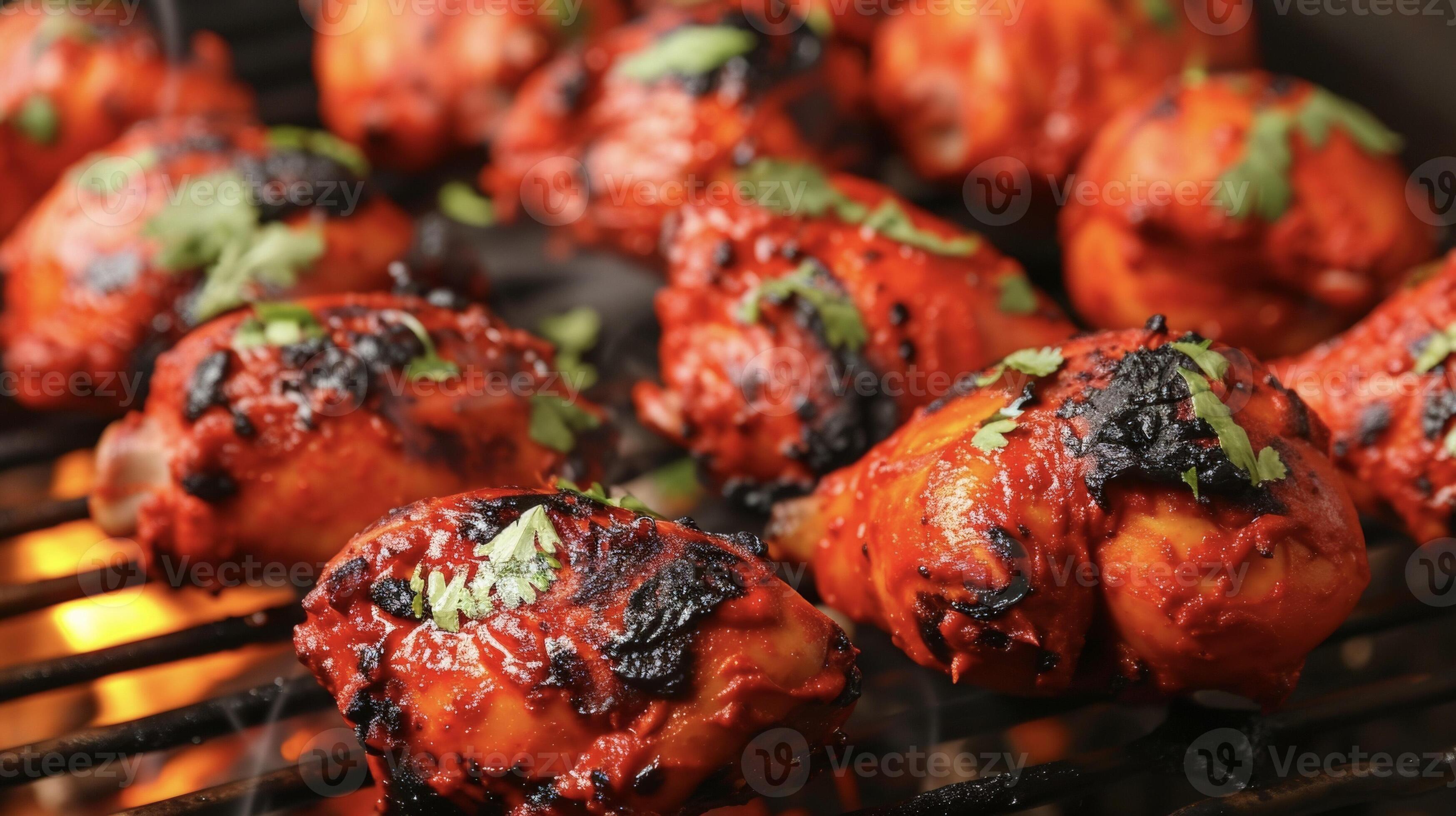Tandoori chicken is one of the most popular Indian dishes around the world. Known for its bright red color and smoky, charred flavors, it’s a staple at Indian restaurants globally. But have you ever wondered why tandoori chicken is red in the first place?
The bright red color of tandoori chicken comes mostly from two things: the spice rub that has red Kashmiri chilies and paprika in it. Let’s look at the history and science behind this famous dish to find out how it gets its color.
A Brief History of Tandoori Chicken
While tandoori dishes have been around for centuries in India, tandoori chicken as we know it today originated in Delhi in the mid-20th century. It was invented by a restaurant called Moti Mahal, founded by Kundan Lal Gujral in 1920s Delhi.
The story goes that one night the tandoor oven at Moti Mahal wasn’t hot enough to properly cook naan. To avoid waste, the chef experimented by marinating pieces of chicken and cooking them in the cooler tandoor. The results were so delicious that tandoori chicken was added to the menu, and the rest is history.
Initially the chicken was marinated with mild spices that gave it a light yellow color. It wasn’t the vibrant red we see today. The iconic red color was a later addition possibly to make the dish more visually striking.
Where Does the Red Color Come From?
The red color of tandoori chicken mainly comes from two ingredients used in the marinade – Kashmiri red chiles and paprika/red chili powder. Let’s look at each of these:
Kashmiri Red Chiles
These dried chiles are a key ingredient in traditional tandoori chicken recipes. Kashmiri chiles come from the Kashmir region in northern India known for producing these deep red chiles.
The vibrant red color of Kashmiri chiles is due to a pigment called capxanthin. When the chiles are dried and ground into a powder, this red pigment permeates the chicken meat, giving it that rich red tone.
However, powdered Kashmiri chiles alone don’t impart a bright enough red They give a more muted, orangey-red color To get that really vibrant crimson, another ingredient is needed – paprika.
Paprika/Red Chili Powder
Paprika is made from grinding dried sweet red peppers. The red pigments from paprika help amplify and brighten the redness imparted by the Kashmiri chile powder.
Traditionally, only a mild paprika was used in tandoori rubs, which lent a delicate redness. But modern recipes often use a bolder, brighter paprika or even red food coloring to amp up the red tones.
The fiery color of tandoori chicken comes from Kashmiri chilies, which give it a deep red base, and paprika, which adds brighter red tones.
The Science Behind the Redness
The natural pigments that give Kashmiri chiles and paprika their red color belong to a class of antioxidant compounds called carotenoids.
The specific carotenoids responsible for the red tones are capsanthin (in Kashmiri chiles) and capsanthin, capsorubin (in paprika). They are fat-soluble compounds, so they easily penetrate the chicken’s skin and flesh when marinated in oil and yogurt.
When exposed to heat from the tandoor oven, these carotenoids undergo chemical changes that intensify their redness. The high temperature helps break down the pigment molecules and spread the redness throughout the meat.
-
Kashmiri chiles contain the red carotenoid capsanthin
-
Paprika contains capsanthin and capsorubin
-
These fat-soluble pigments are carried into the chicken via oily marinades
-
High heat from the tandoor makes the pigments brighter and more spread out
This combination of ingredients and cooking techniques is what gives tandoori its iconic scarlet color. Pretty cool science!
Why Are Artificial Colors Added?
A lot of modern tandoori chicken recipes use artificial colors to make the meat look more red. Why is that?.
A strong red color can be added by natural Kashmiri chiles and paprika, but it’s not always as bright as the restaurant version. Some chefs add a little artificial food coloring to make the red color stand out more.
The most common one used is Red Dye #40 (Allura Red AC). It provides a cheap and easy way to amp up the visual appeal. A dash of red dye makes the chicken look neon red instead of the more muted natural tone.
However, there are some health concerns around artificial food dyes like Red #40. Natural food advocates argue that the natural ingredients should provide enough redness without artificial additives.
So while added red dye provides visual appeal, it comes at the cost of using natural ingredients. It’s a matter of preference and philosophy.
Regional Variations in Color and Spices
While red is the most common color, tandoori chicken recipes across India use various spice blends that result in different shades.
In Punjab, recipes tend to be redder due to abundant use of Kashmiri chiles and paprika. In the south, flavors like curry leaves and coriander lend a more yellow tone. Parts of North India give a whitish tandoori chicken due to spices like chaat masala and the use of unripe green papaya.
So while red is the most popular in restaurants worldwide, regional recipes do vary greatly in spices, ingredients and color. The red isn’t as dominant in traditional home-cooked versions.
The quintessential red color of tandoori chicken comes from the Kashmiri chiles and paprika in the classic north Indian marinade recipe. The natural red carotenoid pigments penetrate the meat and get intensified by the high heat from the tandoor oven.
While artificial red dye is sometimes added for visual impact, traditional recipes rely solely on those vibrant natural spices for both flavor and color.
The next time you savor perfectly roasted tandoori chicken, you’ll have a deeper appreciation for the chemistry and history behind its striking red color. It’s a fantastic example of how cooking methods, spice blends and food chemistry combine to create an iconic dish.

How long can you store leftovers in the fridge?
This tandoori chicken recipe is best served hot, right off the grill. That said, if you do have any leftovers you can store them, covered in your fridge for at least 3 days.
The leftovers can be served hot or cold. If you want to serve your tandoori chicken legs hot, just place them in your microwave for a couple of minutes or better, place them in an air fryer set to 200°C/400°F for about 5 minutes or until heated through.
Why is the tandoori chicken bright red?
Im afraid that is completely down to food colouring. It’s not necessary, but many people like how it makes the chicken look fiery hot.
There is red chilli powder in the recipe so even if you dont use red food colouring, it will still have a natural red tone to it. The red food colouring adds no flavour so it really is a personal thing whether you use it or not.
Tandoori Chicken — Grilled or Broiled
FAQ
What makes tandoori chicken red?
If you are using fresh spices, the paprika will have turned the marinade a lovely red color; if you feel this is not strong enough, then add the drops of food …May 30, 2025.
Why is tandoori meat red?
Tandoori masala is the name of the spice mix used to make this dish. The fiery red color comes from a mix of cayenne pepper and red chili powder or Kashmiri red chili powder. If a higher amount of turmeric is used, then the dish takes on a more yellowy colour.
What gives tandoori chicken its color?
As you can see, the salmon in this picture has a bit of food coloring added to it. But some cooks use mild chili powder or a good amount of paprika, which is what I do here. Feb 24, 2024.
Why is Indian chicken so red?
In India, cochineal dye is used to paint the chicken its traditional fiery red hue, but a little red food coloring does the trick nicely. The chicken is delicious whether served hot or at room temperature.
